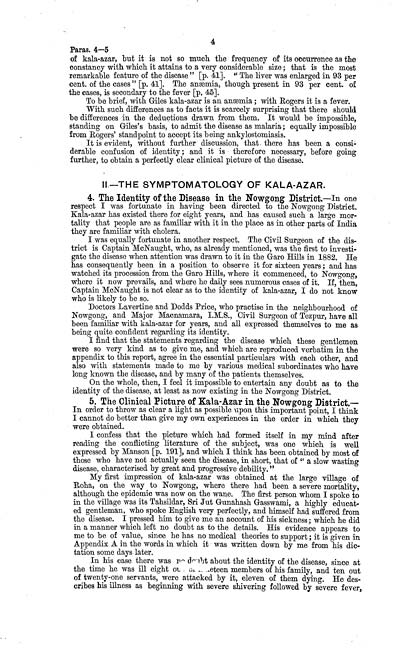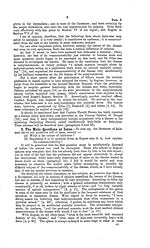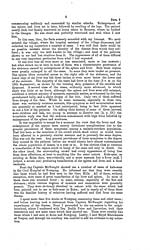Medicine - Disease > Report on the nature of kala-azar
(12) Page 4 - II - The symptomatology of kala-azar
Download files
Individual page:
Thumbnail gallery: Grid view | List view

4
Paras. 4-5
of kala-azar, but it is not so much the frequency of its occurrence as the
constancy with which it attains to a very considerable size; that is the most
remarkable feature of the disease " [p. 41]. " The liver was enlarged in 93 per
cent. of the cases " [p. 41]. The anmia, though present in 93 per cent. of
the cases, is secondary to the fever [p. 45].
To be brief, with Giles kala-azar is an anmia; with Rogers it is a fever.
With such differences as to facts it is scarcely surprising that there should
be differences in the deductions drawn from them. It would be impossible,
standing on Giles's basis, to admit the disease as malaria; equally impossible
from Rogers' standpoint to accept its being ankylostomiasis.
It is evident, without further discussion, that there has been a consi-
derable confusion of identity; and it is therefore necessary, before going
further, to obtain a perfectly clear clinical picture of the disease.
II-THE SYMPTOMATOLOGY OF KALA-AZAR.
4. The Identity of the Disease in the Nowgong District.--In one
respect I was fortunate in having been directed to the Nowgong District.
Kala-azar has existed there for eight years, and has caused such a large mor-
tality that people are as familiar with it in the place as in other parts of India
they are familiar with cholera.
I was equally fortunate in another respect. The Civil Surgeon of the dis-
trict is Captain McNaught, who, as already mentioned, was the first to investi-
gate the disease when attention was drawn to it in the Garo Hills in 1882. He
has consequently been in a position to observe it for sixteen years; and has
watched its procession from the Garo Hills, where it commenced, to Nowgong,
where it now prevails, and where he daily sees numerous cases of it. If, then,
Captain McNaught is not clear as to the identity of kala-azar, I do not know
who is likely to be so.
Doctors Lavertine and Dodds Price, who practise in the neighbourhood of
Nowgong, and Major Macnamara, I.M.S., Civil Surgeon of Tezpur, have all
been familiar with kala-azar for years, and all expressed themselves to me as
being quite confident regarding its identity.
I find that the statements regarding the disease which these gentlemen
were so very kind as to give me, and which are reproduced verbatim in the
appendix to this report, agree in the essential particulars with each other, and
also with statements made to me by various medical subordinates who have
long known the disease, and by many of the patients themselves.
On the whole, then, I feel it impossible to entertain any doubt as to the
identity of the disease, at least as now existing in the Nowgong District.
5. The Clinical Picture of Kala-Azar in the Nowgong District.-
In order to throw as clear a light as possible upon this important point, I think
I cannot do better than give my own experiences in the order in which they
were obtained.
I confess that the picture which had formed itself in my mind after
reading the conflicting literature of the subject, was one which is well
expressed by Manson [p. 191], and which I think has been obtained by most of
those who have not actually seen the disease, in short, that of " a slow wasting
disease, characterised by great and progressive debility. "
My first impression of kala-azar was obtained at the large village of
Roha, on the way to Nowgong, where there had been a severe mortality,
although the epidemic was now on the wane. The first person whom I spoke to
in the village was its Tahsildar, Sri Jut Gunahash Gasswami, a highly educat-
ed gentleman, who spoke English very perfectly, and himself had suffered from
the disease. I pressed him to give me an account of his sickness; which he did
in a manner which left no doubt as to the details. His evidence appears to
me to be of value, since he has no medical theories to support; it is given in
Appendix A in the words in which it was written down by me from his dic-
tation some days later.
In his case there was no doubt about the identity of the disease, since at
the time he was ill eight out of nineteen members of his family, and ten out
of twenty-one servants, were attacked by it, eleven of them dying. He des-
cribes his illness as beginning with severe shivering followed by severe fever,
Paras. 4-5
of kala-azar, but it is not so much the frequency of its occurrence as the
constancy with which it attains to a very considerable size; that is the most
remarkable feature of the disease " [p. 41]. " The liver was enlarged in 93 per
cent. of the cases " [p. 41]. The anmia, though present in 93 per cent. of
the cases, is secondary to the fever [p. 45].
To be brief, with Giles kala-azar is an anmia; with Rogers it is a fever.
With such differences as to facts it is scarcely surprising that there should
be differences in the deductions drawn from them. It would be impossible,
standing on Giles's basis, to admit the disease as malaria; equally impossible
from Rogers' standpoint to accept its being ankylostomiasis.
It is evident, without further discussion, that there has been a consi-
derable confusion of identity; and it is therefore necessary, before going
further, to obtain a perfectly clear clinical picture of the disease.
II-THE SYMPTOMATOLOGY OF KALA-AZAR.
4. The Identity of the Disease in the Nowgong District.--In one
respect I was fortunate in having been directed to the Nowgong District.
Kala-azar has existed there for eight years, and has caused such a large mor-
tality that people are as familiar with it in the place as in other parts of India
they are familiar with cholera.
I was equally fortunate in another respect. The Civil Surgeon of the dis-
trict is Captain McNaught, who, as already mentioned, was the first to investi-
gate the disease when attention was drawn to it in the Garo Hills in 1882. He
has consequently been in a position to observe it for sixteen years; and has
watched its procession from the Garo Hills, where it commenced, to Nowgong,
where it now prevails, and where he daily sees numerous cases of it. If, then,
Captain McNaught is not clear as to the identity of kala-azar, I do not know
who is likely to be so.
Doctors Lavertine and Dodds Price, who practise in the neighbourhood of
Nowgong, and Major Macnamara, I.M.S., Civil Surgeon of Tezpur, have all
been familiar with kala-azar for years, and all expressed themselves to me as
being quite confident regarding its identity.
I find that the statements regarding the disease which these gentlemen
were so very kind as to give me, and which are reproduced verbatim in the
appendix to this report, agree in the essential particulars with each other, and
also with statements made to me by various medical subordinates who have
long known the disease, and by many of the patients themselves.
On the whole, then, I feel it impossible to entertain any doubt as to the
identity of the disease, at least as now existing in the Nowgong District.
5. The Clinical Picture of Kala-Azar in the Nowgong District.-
In order to throw as clear a light as possible upon this important point, I think
I cannot do better than give my own experiences in the order in which they
were obtained.
I confess that the picture which had formed itself in my mind after
reading the conflicting literature of the subject, was one which is well
expressed by Manson [p. 191], and which I think has been obtained by most of
those who have not actually seen the disease, in short, that of " a slow wasting
disease, characterised by great and progressive debility. "
My first impression of kala-azar was obtained at the large village of
Roha, on the way to Nowgong, where there had been a severe mortality,
although the epidemic was now on the wane. The first person whom I spoke to
in the village was its Tahsildar, Sri Jut Gunahash Gasswami, a highly educat-
ed gentleman, who spoke English very perfectly, and himself had suffered from
the disease. I pressed him to give me an account of his sickness; which he did
in a manner which left no doubt as to the details. His evidence appears to
me to be of value, since he has no medical theories to support; it is given in
Appendix A in the words in which it was written down by me from his dic-
tation some days later.
In his case there was no doubt about the identity of the disease, since at
the time he was ill eight out of nineteen members of his family, and ten out
of twenty-one servants, were attacked by it, eleven of them dying. He des-
cribes his illness as beginning with severe shivering followed by severe fever,
Set display mode to: Large image | Zoom image | Transcription
Images and transcriptions on this page, including medium image downloads, may be used under the Creative Commons Attribution 4.0 International Licence unless otherwise stated. ![]()
| India Papers > Medicine - Disease > Report on the nature of kala-azar > (12) Page 4 - II - The symptomatology of kala-azar |
|---|
| Permanent URL | https://digital.nls.uk/74580928 |
|---|---|
| Description | II.: The symptomatology of kala-azar |




